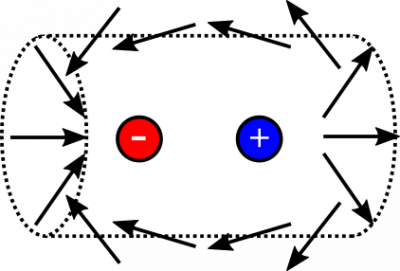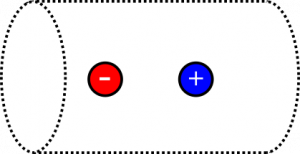This is an old revision of the document!
Example: Flux from a Dipole
Suppose you have a two charges, one with value $5 \mu\text{C}$, the other with value $5 \mu\text{C}$. There are at separate locations, a distance $1 \text{ m}$ apart, and they can be modeled as a dipole. What is the flux through a cylinder with radius $4 \text{ m}$ and length $16 \text{ m}$ that encloses this dipole?
Facts
- The dipole charges are $q=5 \mu\text{C}$, $-q=-5 \mu\text{C}$.
- The dipole distance is $1 \text{ m}$.
- The cylinder has radius $4 \text{ m}$ and length $16 \text{ m}$.
Lacking
- $\Phi_e$ through the cylinder
Approximations & Assumptions
- The axis of the cylinder is aligned with the dipole.
- The dipole and cylinder are centered with respect to each other.
- The electric flux through the cylinder is due only to the dipole (i.e., no other charges exist).
- The charges are point charges, which indeed means we can model them as a dipole.
Representations
Solution
First, notice that we probably do not want to do any calculations here, since the it will not be fun to take a dot-product of the dipole's electric field and the area-vector, and it will very messy very quickly when we start integrating over the surface of the cylinder. Instead, we evaluate the situation more qualitatively. Consider the electric field lines of the dipole:

